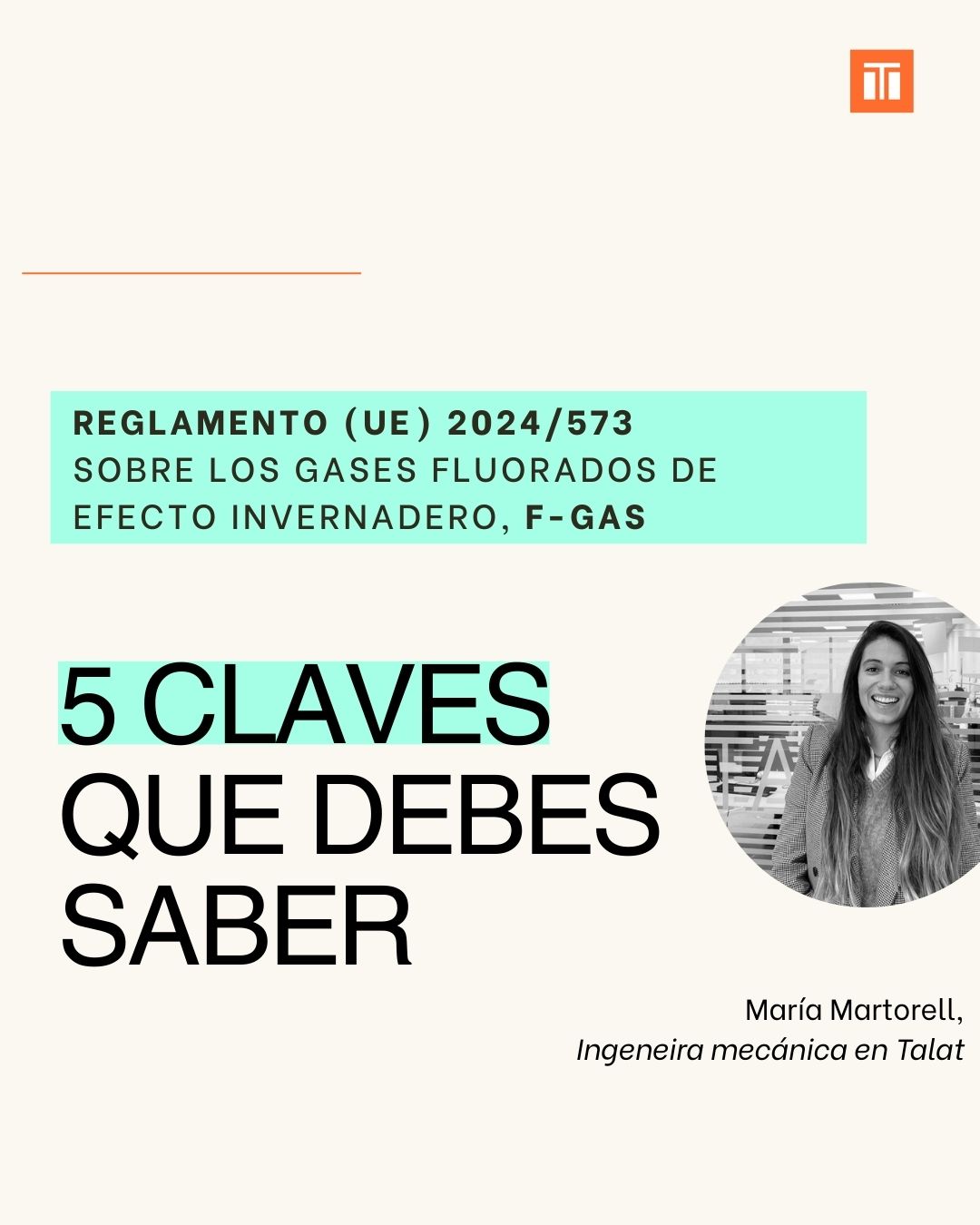On International Earth DayAt Talat, we are committed to the most urgent cause of all: restoring and protecting our atmosphere, starting with the ozone layerDid you know that an essential step in that direction is to adapt to the new Regulation (EU) 2024/573 on fluorinated gases (F-Gas)? Today we talk about the 5 keys you should know to take care of the planet (and comply with the regulations).
This regulation, in force since February 7, 2024not only redefines how our industry works with refrigerants, but it also marks a before and after in the fight against climate change.
Our mechanical engineer Maria Martorell has summarized in 5 keys what any technical professional or company in the sector should be clear about in order to comply with regulations and move towards a more sustainable model. Here we share them with you:

1.Understanding the origin: from the Montreal Protocol to the F-Gas regulation
It all starts at 1987with the Montreal ProtocolThe world unites to eliminate substances that deplete the ozone layer. As a consequence, the use of the F-Gaseswhich do not directly affect the ozone, but have a significant high global warming potential (GWP).
Thus, in 2019 the amendment begins to be implemented. Kigali to the Montreal Protocol. This agreement provides that over the next 30 years, a reduction of more than 80% of projected production and consumption of hydrofluorocarbons (HFCs), organic compounds frequently used in air conditioners and other devices as alternative refrigerants to the ozone-depleting substances regulated by the Montreal Protocol.
2. Regulatory context. How did we get to regulation (EU) 2024/573?
Among the main turning points of this reduction regulation, we can look back to 2015When the EU began to gradually reduce the amount of F-gases that can be placed on the market, specifically HFCs. Thus, the revised regulation (EU Regulation 517/2014) which replaces the previous regulation (842/2006). It establishes reduction targets for fluorinated gases and control measures. The first step was a 79% reduction by 2030 from 2015 levels.
Over the next few years and until 2020, the reduction continued with the goal of lowering emissions by a total of approximately 37% of 2015 levels by 2020. Thus, in 2021In addition, a new reduction in the quota of available HFCs (hydrofluorocarbons) is implemented, reaching a 55% decrease. From this point until the recent regulation approved on February 7, 2008, the 2025, the target was a further reduction, approaching 60% of 2015 levels. Among other actions, which were carried out was the prohibition in 2024 The company is prohibited from marketing centralized refrigeration systems for supermarkets that use gases with a GWP greater than 150, unless they are designed to operate with secondary refrigerants.
3. Familiarization with Least Impact Coolants
Do you know what it consists of global warming potential (GWP) of a refrigerant? It is a measure of the impact a gas has on global warming compared to carbon dioxide (CO₂). The higher the GWP, the greater its contribution to climate change. The more sustainable refrigerants include natural refrigerants such as CO₂ (R-744), ammonia (R-717) and hydrocarbons such as propane (R-290), as well as new generations of HFOs.
The transition to refrigerants with under GWPsuch as HFOs and natural refrigerants, is one of the most effective ways to reduce the environmental impact of refrigeration systems. These refrigerants have a lower impact on climate change without sacrificing efficiency. An example is the R-1234yfused in many new cars, has a GWP close to zero, making it a very attractive alternative to HFCs.
4. To be clear about the objectives of Regulation 2024/573.
The regulation promotes the transition to more sustainable alternatives, limits emissions through quotas and obliges the maintenance and control of leaks in equipment. It also promotes technical training and professional certification to ensure compliance.
This legislation is key to the EU's decarbonization strategy and fundamental to achieving the climate targets and moving towards a more efficient and sustainable more sustainable economic model. Thus, many of today's space heating and cooling systems are gradually being replaced by "clean" systems, i.e., with no direct CO2 from the hydrocarbon combustion whose main source is electricity. The objectives can be grouped into 5 key areas:
✅ Phasing out the use of HFCs
🎯Target 2030: Reduce by 79 % HFC use compared to 2015 levels.
🎯Target 2050To achieve a reduction of 90 %contributing to the climate neutral of the EU.
Establishment of production and import quotassubject to control and registration through a licensing system.
✅ Promoting the use of sustainable alternatives
Promotion of refrigerants with low or no GWPsuch as CO₂, ammonia, hydrocarbons and water.
Inclusion of restrictions and prohibitions progressive reductions on equipment containing high GWP gases when viable alternatives are available.
Application of criteria for technical and economic feasibility to justify temporary exceptions.
✅ Circular economy measures and leakage control
Recovery, recycling y regeneration emissions at the end of the equipment's useful life.
Periodic maintenance and control of leaks in existing systems.
Prohibition of non-refillable containers and promotion of return mechanisms for reusable products.
Introduction of declarations of conformity that certify the correct environmental treatment of the gases.
✅ Strengthening traceability and customs controls
Compulsory registration of all imports/exports in the EU F-Gas Portal.
Interconnection of the portal with customs single window systems to facilitate automated inspections.
Reinforcement of measures against illegal trade of F-Gas.
✅Training, certification and awareness
Mandatory professional training and certification for those who install, maintain or repair equipment with fluorinated gases.
Inclusion of topics of energy efficiency, alternative technologies y technical standards in the training programs.
Maintenance of validity for certificates issued under the previous regulation (Regulation 517/2014), but with necessary updating.
5. New performances that are here to stay
The new F-Gas regulation introduces a series of measures that represent relevant changes with respect to the previous regulation. One of the most important measures is the mandatory refresher training and certification for professionals in the sector. Technicians working with fluorinated gases or alternative technologies must have specific training that includes knowledge on energy efficiency, safety and handling of refrigerants with low global warming potential. In addition, existing training programs will need to be revised to adapt to the new requirements.
Strengthening of the traceability and customs control through the creation of a mandatory european portal to register all production, import and commercialization activities of F-Gases and products containing them. This portal will be connected to the customs single window system, which will allow for stricter and real-time monitoring, especially to prevent illegal trade.
A novel addition is the inclusion of the health sector in the HFC quota system. Specifically, metered dose inhalers for respiratory diseases should move towards the use of propellants with lower climate impact, with a planned transition to 2030.
Strong emphasis is placed on the circular economy, promoting the recycling and reclamation of recovered gases, and including specific requirements for the proper management of waste electrical and electronic equipment containing F-Gases.
Finally, the regulation tightens the penalty regime, requiring Member States to establish effective, proportionate and dissuasive penalties. It also promotes a closer customs-to-customs collaborationThe aim is to improve market surveillance and fight against infringements.
Here at Talat, we are already updating our operations and training to comply with these regulations and be an active part of the change 🌱🌍.

